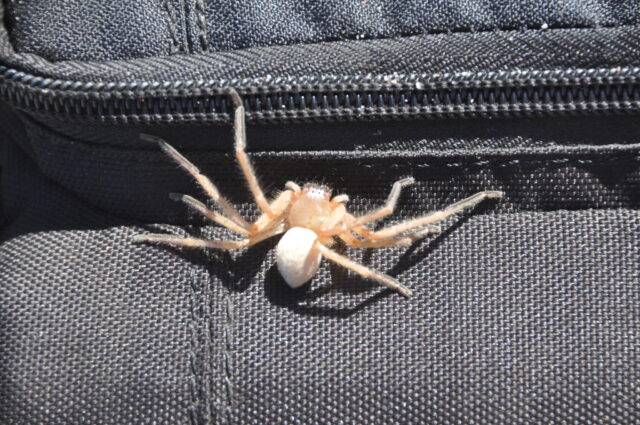A few weeks ago an interesting post came across my Facebook feed. It featured a BBC article describing a species of spider I was not previously aware of. This spider’s main claim to fame was a unique behavior that I also had never heard of before.
BBC EARTH NEWS: Madagascar’s Elusive Shell-squatting Spider Filmed
Coming away from reading the article, my expectation was that I am likely not alone in these areas of ignorance, so I though it might be nice to pass information about this spider on to a broader audience… namely, you guys. Meet the fascinating Olios coenobitus, a huntsman spider also known as the Shell-squatting Spider.


(shown in green)
The Shell-squatting Spider is not found in Texas; it is a native of the island of Madagascar, which is located in the Indian Ocean, just off the east coast of Africa.
Madagascar is considered one of the world’s biodiversity hotspots, due in large part to its unique geological history. Somewhere around 90% of the plants and animals living on Madagascar are found nowhere else on Earth. Olios coenobitus is one of these uniquely Madagascan organisms.
Madagascar has many and varied climate regions. Everything from tropical rainforests, to tropical savannahs, to temperate zones, to arid steppes and deserts can be found on the island. The Shell-squatting Spider makes its home in the dry, hot regions located along the southern coast.

The Shell-squatting Spider is a member of the Olios genus, and according to Wikipedia, this is the largest genus of huntsman spiders, including some 165 different species. The behavior that distinguishes the Shell-squatting Spider from the others in this genus is the clever way it has developed to shelter from the challenging hot and dry climate it lives in.
As the spider’s name implies, Olios coenobitus makes its home inside an abandoned snail shell. But that’s not the end of the story. The truly remarkable aspects of this spider’s preference for snail shell shelters is how they are prepared.
When the Shell-squatting Spider finds a suitable vacated snail shell, it begins the preparation process by first descending from overhanging vegetation on a thread of silk. This strand of webbing is then attached to the shell. Next the spider produces another webbing attachment point on the snail shell, and then climbs back up into the vegetation, trailing this strand behind as it goes.
The spider will stop its ascent just short of its original starting point, requiring the spider to lift the snail shell slightly before it can attach this thread of webbing to the overhanging vegetation. The Shell-squatting Spider then repeats this process of descents, ascents, and lifts, over and over again, until the snail shell has been suspended a suitable distance off the ground and firmly secured by numerous strands of webbing.

Recently, a BBC film crew, working on a series about Madagascar, was able to film a Shell-squatting Spider at work, collecting what is believed the first footage of this unique behavior ever recorded. Reportedly, it was a challenging assignment. The results of their determined efforts can be seen in the video below…
This complicated behavior is impressive for a number of reasons. The Shell-squatting Spider must begin by first selecting an appropriate snail shell. That means the spider must be able to accurately distinguish a snail shell from other items in its environment, and recognize whether it is abandoned or not. At the same time, the spider must choose a shell that is of an optimal size. The shell has to be big enough to hold the spider, but not so large that it is too unwieldy to lift. There is no indication that the Shell-squatting Spider will make an effort to move a snail shell into position under suitable vegetation. This means the spider must be capable of identifying when a snail shell is stationed in a fortuitous location before it attempts a lift. And, during the lifting process, the spider must be able to successfully compensate for environmental difficulties, such as wind and rain. That’s a lot of processing power demanded of a tiny, little spider brain.
Through further research online, I discovered evidence that there may be at least a few other species of spiders that will make use of vacated snail shells as shelters. Information is sketchy, but I found posts suggesting similar sheltering behavior in spiders from places as varied as Australia, Tennessee, and the Czech Republic. And while it was suggested that these different species of spiders DID live in abandoned snail shells, there were no indications that any of these spiders engaged in the unique shell lifting behavior exhibited by Olios coenobitus.
For those who are interested in additional reading I have included below a link to the BBC Earth News article–together with those of a few other related topics…
BBC EARTH NEWS: Madagascar’s Elusive Shell-squatting Spider Filmed
BBC YOUTUBE: Small Spider Lifts Snail Shell Up Tree – Madagascar – BBC
WIKIPEDIA: Spider Genus Olios
WIKIPEDIA: Madagascar

